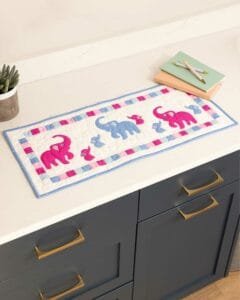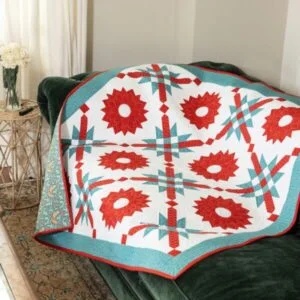The Housewife Quilt Block is a timeless design that has been passed down through generations, bringing a classic touch to any quilt. This Housewife Quilt Block – Tutorial will guide you step by step in creating this beautiful quilt block.
Whether you’re a beginner or a seasoned quilter, this guide will make the process simple and enjoyable. By the end of this article, you’ll have a solid understanding of how to craft your own Housewife Quilt Block, adding a unique and personal touch to your quilting projects.
The Housewife Quilt Block is characterized by its simplicity and elegance. It combines different fabrics and patterns, creating a harmonious design that can be tailored to suit your personal style.
Quilting is not just a craft but a form of expression, and the Housewife Quilt Block allows you to showcase your creativity in a practical way.
In this tutorial, we’ll go through all the necessary materials, steps, and techniques to make your Housewife Quilt Block. Follow along carefully, and don’t hesitate to experiment with different fabrics and colors to create a block that’s truly yours. Now, let’s dive into the process and start quilting!
1. Gathering Materials for the Housewife Quilt Block
Before you begin creating your Housewife Quilt Block, it’s important to gather all the necessary materials. Having the right tools and fabrics will ensure a smooth process and result in a high-quality quilt block.
- Choosing the Right Fabric: The fabric you choose will determine the overall look of your Housewife Quilt Block. It’s best to select fabrics that complement each other in color and pattern. Traditional cotton fabrics work best, as they are easy to handle and durable.
- Cutting Tools: A sharp rotary cutter and a cutting mat are essential tools for ensuring that your fabric pieces are cut accurately. Precision is key in quilting, and having well-cut pieces will make assembling the block much easier.
- Sewing Machine: While you can sew quilt blocks by hand, using a sewing machine will save time and provide more uniform stitches. Make sure your machine is properly threaded and ready to go before you start.
- Measuring Tools: A quilting ruler is a must-have for measuring your fabric pieces. Accurate measurements are critical to ensure that your Housewife Quilt Block comes together smoothly.
- Pins and Needles: Pins will help hold your fabric pieces in place while sewing, and sharp needles are necessary for both hand and machine stitching.
- Ironing Board and Iron: Pressing your fabric pieces as you work is crucial for achieving crisp seams and a polished look. Make sure your ironing board is set up and your iron is ready to press your pieces flat.
2. Cutting and Preparing the Fabric
Now that you have all your materials ready, it’s time to start cutting and preparing your fabric for the Housewife Quilt Block. Follow these steps to ensure precision in your cuts.
- Cutting the Squares: Begin by cutting your fabric into squares. Typically, the Housewife Quilt Block uses 4 to 6-inch squares, depending on the size of the block you want to create. Make sure to cut your squares evenly.
- Cutting the Triangles: Once your squares are cut, you’ll need to cut some of them diagonally to create triangles. These triangles will form part of the pattern for your Housewife Quilt Block, giving it a distinctive look.
- Laying Out the Pieces: Before you start sewing, lay out all the pieces on your work surface to get a sense of how the block will come together. This will allow you to make any adjustments before sewing.
- Marking the Seams: Use a fabric marker or pencil to mark your seam allowances. A ¼-inch seam allowance is standard for quilt blocks. Marking your seams in advance will help you sew with accuracy.
- Pressing the Pieces: Before you start sewing, press all your fabric pieces with an iron to remove any wrinkles. This will make it easier to sew straight seams and ensure that your block lies flat.
- Organizing the Pieces: Keep your fabric pieces organized by stacking them in the order in which you will sew them. This will help prevent mistakes and keep the process smooth.
3. Sewing the Housewife Quilt Block
With your fabric pieces prepared, it’s time to start sewing your Housewife Quilt Block. Follow these steps to assemble the block.
- Sewing the Squares: Begin by sewing the squares together. Use a ¼-inch seam allowance and be sure to sew straight. If you’re using a sewing machine, set it to a straight stitch.
- Sewing the Triangles: Once your squares are sewn, it’s time to sew the triangles. These will be added to the edges of your block to create the characteristic shape of the Housewife Quilt Block.
- Pressing the Seams: After each seam is sewn, press it flat with your iron. Press the seams open to reduce bulk and ensure the block lies flat.
- Joining the Rows: Once all your pieces are sewn together, join the rows of squares and triangles. Be sure to match up the seams carefully to ensure a clean finish.
- Checking for Accuracy: As you sew, periodically check your work to make sure everything is lining up correctly. If necessary, make adjustments to your seams.
- Final Pressing: Once your block is fully assembled, give it one final press to ensure all the seams are flat and the block is neat.
4. Finishing Touches and Assembly
The final step in this Housewife Quilt Block Tutorial is to finish the block and prepare it for assembly into a quilt.
- Trimming the Block: Once your block is sewn, use your rotary cutter and ruler to trim any excess fabric from the edges. This will ensure that all your blocks are uniform in size when you assemble them into a quilt.
- Adding Borders: If desired, you can add borders to your Housewife Quilt Block. Borders can enhance the appearance of the block and provide a frame for the design.
- Combining Blocks: Once you have multiple blocks, you can start sewing them together to form a quilt. Lay out the blocks to decide on the final arrangement before sewing.
- Pressing the Quilt Top: As you assemble the quilt top, continue to press the seams to ensure the quilt lies flat and looks polished.
- Quilting the Layers: Once the quilt top is assembled, you’ll need to quilt it by sewing it together with the batting and backing fabric. This step adds texture and durability to the quilt.
- Binding the Quilt: The final step is to bind the edges of the quilt. Binding adds a finished look and protects the edges from fraying.
FAQ
What is the Housewife Quilt Block?
The Housewife Quilt Block is a traditional quilt block design known for its simple and elegant pattern. It is often used in quilts for its timeless appeal.
Can beginners make the Housewife Quilt Block?
Yes, the Housewife Quilt Block is beginner-friendly. With basic sewing skills and the right tools, anyone can create this quilt block.
What size should the Housewife Quilt Block be?
The size can vary, but the Housewife Quilt Block typically measures between 6 to 12 inches, depending on the desired quilt size.
What fabrics work best for the Housewife Quilt Block?
Cotton fabrics are ideal for the Housewife Quilt Block because they are easy to work with and hold their shape well.
Do I need a sewing machine to make the Housewife Quilt Block?
While a sewing machine is recommended for faster and more uniform stitching, the Housewife Quilt Block can also be sewn by hand.
How do I incorporate the Housewife Quilt Block into a larger quilt?
You can combine multiple Housewife Quilt Blocks to create a larger quilt. Simply sew the blocks together in rows, pressing the seams as you go.
Conclusion
In this Housewife Quilt Block – Tutorial, you’ve learned the essential steps to create a beautiful quilt block from start to finish. By following these instructions, you can craft your own Housewife Quilt Block and incorporate it into a larger quilt project. We hope this guide has inspired you to start quilting and experiment with different fabrics and colors. Don’t forget to leave your feedback and suggestions in the comments section below! We’d love to hear your thoughts and see your creations!



